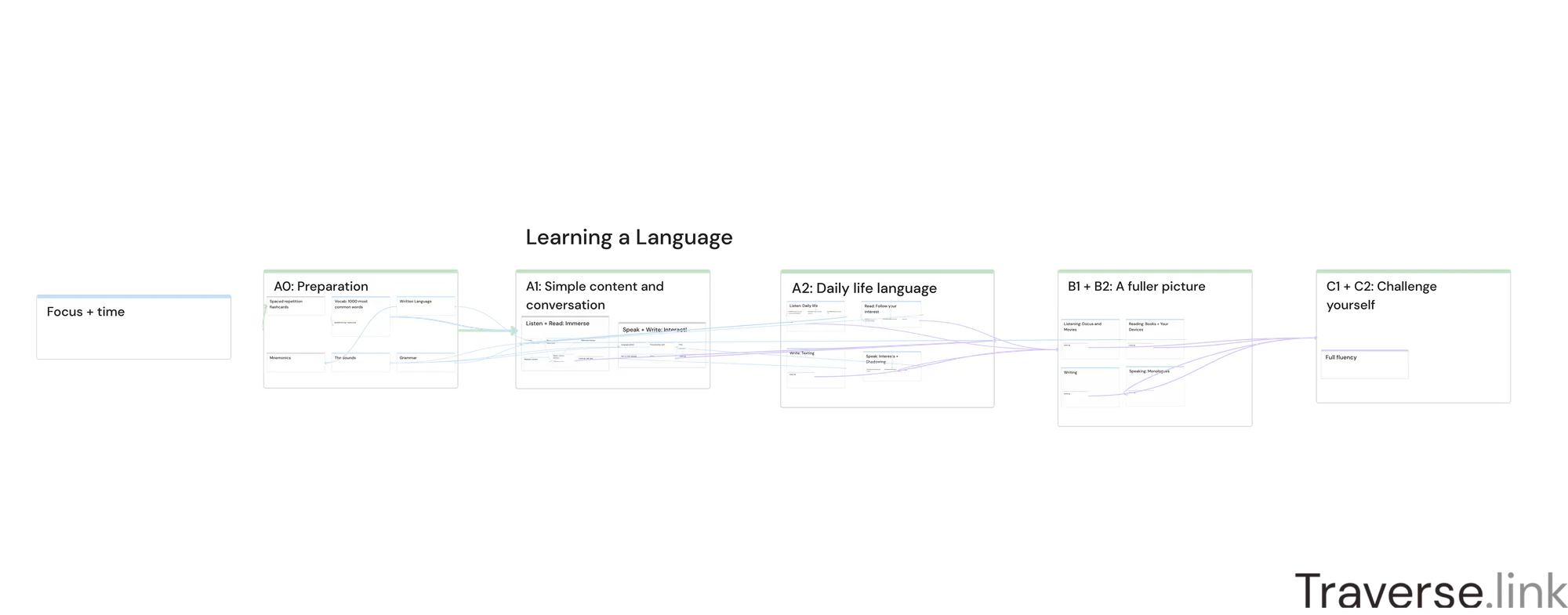Learning any language can seem daunting. But it doesn’t need to be.
By the end of this article you’ll know exactly what steps you can take to learn that language you’ve always wanted to learn.
These steps have been battle tested by myself over the past 10 years. Being dutch, I learned German as a child. Later I learned Brazilian Portuguese, French (in 90 days!), and some Spanish and Italian. I started learning Mandarin after I met my wife, who is Chinese.
This motivated me to really refine my methods. You can use those exact steps as well to learn any language in a matter of months:
Define your goal: Why do you want to learn this language?
What are you you trying to achieve? This helps you focus only on the steps that take you to your goal faster, while skipping anything else. This adheres to Scott Young's learning principle of directness: directly practice the skill you want to get better add. If you want to read, read! If you want to speak, speak!
Planning and focus time
In learning, it's the number of hours that counts, not the number of months. Whether you have one hour a day or eight, the number of hours required to learn a language stays roughly the same: around 500-1000 for a decent level. You need to schedule blocks of the following three types:
- Long focus time (for immersion)
- Short focus time (for flashcard reviews)
- Non-focused time (for passive listening throughout your day) Now that you've set a goal and scheduled time, follow these steps accodring to the European Reference Frameworke level you're at.
A0: Preparation
Set up spaced repetition flashcards for:
- Most frequently used words (according to the 80/20 principle, the 1000 most used words cover ~80% of speech in any language)
- Unfamiliar sounds
- Skim the grammar without memorizing anything (yet)
A1: Simple content and conversation
- Listen + Read: immerse yourself in simple content like children's shows, and language learning podcasts with authentic language (both with target language subtitles, that match exactly what is being said)
- Do sentence mining: look for new vocab, phrases and grammar patterns in the content which prevent you from understanding
- Create flashcards for all of those and add them to your daily reviews
- Rewatch/re-listen content passively multiple times
- Your goal is to understand the message, not the words
- Speak + Write: find a native language buddy who is patient, and you feel comfortable speaking with
- Practice pronunciation and casual chat with your language buddy, and text with them using WhatsApp, Discord etc
A2: Daily life speech
- Listen to daily life content such as sitcoms, vlogs and podcasts to get a feeling for common expressions used in daily life
- Read comics, children books, as well as blogs and articles in your familiar area of interest (this enables you to master a particular field quickly)
- Talk with your language buddy about your interests. Practice imitating and shadowing your language buddy.
- Start texting with strangers online
B1 + B2: Generalization
- Listen to documentaries, movies, podcast in your area of interest. Start dropping subtitles to focus exclusively on listening.
- Start reading books and keep creating flashcards for new vocab.
- Tip: change your phone and computer display language to the target language, so you are forced to read in daily life
- When speaking, pay attention to using correct target language expressions (go from target language directly to images, rather than through your native language first)
- Practice writing by summarizing content you watch, listen and read, and by keeping a diary
C1 + C2: Challenge yourself
Challenge yourself to avoid plateauing. Try watching comedy, speaking at (online) events in the target language, and writing and publishing blog posts
Let’s review the steps:
1) Plan out your method
2) Prepare your materials
3) Start simple
4) Focus on daily life speech
5) Begin to generalize
6) Challenge yourself.
Taking the first step can often be the most difficult. To help you plan out your method I’ve created an editable, actionable template from these steps. You can use it as your working and learning space for your next language learning project.

